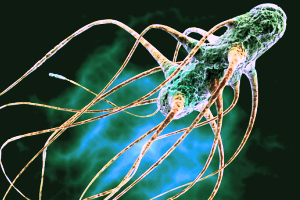Salmonella: Effects on intestinal permeability and on transport

Pathogenic enteric bacteria such as Salmonella are a significant health problem worldwide. Infections with this pathogen are the most frequent cause of food-borne outbreaks of gastroenteritis in adults and children. Salmonella are a major problem to the poultry industry because poultry is still regarded as a main source for human infections.
They are considered asymptomatic carriers, who are shedding the bacteria through faeces without any clinical signs. In adult birds, some serovars are localized in the reproductive tract, may be the reason for the entry of Salmonella into the human food chain. Several potential virulence factors of Salmonella enteritidis may contribute to infection and intestinal mucosal damage. These factors include epithelial invasion, synthesis of an enterotoxin, and induction of an inflammatory response; however, the exact mechanisms by which Salmonella causes mucosal damage are not yet well understood.
The intestinal mucosa acts as a defensive barrier, which selectively permits absorption of nutrients while preventing access by pathogens. This defensive barrier is organized according to the anatomical layers of the mucosa, with the intact epithelium representing the most important physical barrier component for selective and non-selective permeation.
To assess the permeability of this barrier in experiments, the measurement of the trans-mural ion conductance is commonly used. The present investigations aimed to elucidate whether the absence of diarrhoea during acute Salmonella enteritidis infection may be linked to specific changes in the electrophysiological properties of the chicken gut. Immediately after slaughter, intestinal pieces of the mid-jejunum and cecum of either commercial broiler or specific pathogen-free (SPF) chickens were mounted in Ussing chambers. Living Salmonella enteritidis (3 × 109) or Salmonella enteritidis endotoxin (20 mg/L), or both, were added to the mucosal side for 1 h. The Salmonella infection decreased the trans-epithelial ion conductance. In the jejunum of SPF chickens, there was also a marked decrease in net charge transfer across the epithelium, evidenced by decreased short-circuit current. The mucosal application of Salmonella endotoxin to the epithelial preparations from jejunum and caecum of SPF chickens had an effect similar to living bacteria. The endotoxin had no additional effect on the intestinal function in the presence of bacteria.
For the first time, it is reported that intestinal ion permeability of chicken decreases acutely by the presence of Salmonella. This type of response could explain why chickens do not develop overt diarrhoea after Salmonella infection.
(W. A. Awad, J. R. Aschenbach, B. Khayal, C. Hess and M. Hess, Poultry Science 91, pp 2949-2957)
Join 31,000+ subscribers
Subscribe to our newsletter to stay updated about all the need-to-know content in the poultry sector, three times a week. Beheer
Beheer








 WP Admin
WP Admin  Bewerk bericht
Bewerk bericht